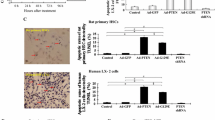Abstract
Adenovirus is a promising gene delivery vector that has a high efficiency and relative simplicity of construction. These advantages make this system attractive for diverse research applications. In this project we transduced hepatics stellatecells (HSC) with adenoviral vector containing genes of hepatocytes growth factor (HGF) and red fluorescent protein (RFP) as a reporter (Adv5-optHGF-RFP), which let us to visualize the transduced cells. Further changes of phenotype were studied by real-time PCR and immunocytochemical staining. According to our results, most of the cells were transduced and demonstrated stable expression of RFP. Effectiveness of the transduction was also confirmed by a high expression of HGF (1200 times higher than in control HSC culture). Adenoviral transduction of HSC with HGF gene did not change their morphology, but stimulated expression of HSC marker desmin, leading to HSC activation (α-smooth muscle actin) and appearance of α-fetoprotein, one of the hepatoblasts markers. During the entire experiment, there were Ki-67+ cells, meaning that proliferation of transduced HSC was not affected. Thus, adenoviral transduction of HSC with Adv5-optHGF-RFP is a good gene delivery system with a stimulating effect on HSC.

Similar content being viewed by others
References
Friedman, S. L. (2008). Hepatic stellate cells: protean, multifunctional, and enigmatic cells of the liver. Physiol Rev, 88, 125–172.
Kordes, C., et al. (2007). CD133+ hepatic stellate cells are progenitor cells. Biochem Biophys Res Commun, 352(2), 410–417.
Kiassov, A. P., et al. (1995). Desmin expressing nonhematopoietic liver cells during rat liver development: an immunohistochemical and morphometric study. Differentiation, 59(4), 253–258.
Kordes, C., et al. (2014). Hepatic stellate cells contribute to progenitor cells and liver regeneration. J Clin Invest, 124(12), 5503–5515.
Birchmeier, C., & Gherardi, E. (1998). Developmental roles of HGF/SF and its receptor, the c-Met tyrosine kinase. Trends Cell Biol, 8, 404–410.
Oh, S. H., et al. (2000). Hepatocyte growth factor induces differentiation of adult rat bone marrow cells into a hepatocyte lineage in vitro. Biochem Biophys Res Commun, 279(2), 500–504.
Snykers, S., et al. (2006). Sequential exposure to cytokines reflecting embryogenesis: the key for in vitro differentiation of adult bone marrow stem cells into functional hepatocyte-like cells. Toxicol Sci, 94(2), 330–341.
Reetz, J., Genz, B., Meier, C., Kowtharapu, B. S., Timm, F., Vollmar, B., et al. (2013). Development of adenoviral delivery systems to target hepatic stellate cells in vivo. PLoS One, 8(6), e67091. doi:10.1371/journal.pone.0067091.
Franceschi, R. T., & Ge, C. (2008). Gene delivery by adenoviruses. In J. J. Westendorf (Ed.), Osteoporosis. Methods and protocols (1st ed., pp. 137–147). Rochester, USA: Humana Press.
Knook, D. L., Seffelaar, A. M., & de Leeuw, A. M. (1982). Fat-storing cells of the rat liver. Exp Cell Res, 132, 468–471.
Nava, S., et al. (2005). Characterization of cells in the developing human liver. Differentiation, 73, 249–260.
Acknowledgements
The work is performed according to the Russian Government Program of Competitive Growth of Kazan Federal University and subsidy allocated to Kazan Federal University for the state assignment in the sphere of scientific activities and financial support by grant №12-04-97088 of the Russian Foundation for Basic Research.
Author information
Authors and Affiliations
Corresponding author
Ethics declarations
Conflicts of Interest
The authors declare no conflicts of interest.
Additional information
Aygul Shafigullina and Elvira Zaikina are equally contributing authors
Rights and permissions
About this article
Cite this article
Shafigullina, A., Zaikina, E., Garanina, E. et al. Effect of Adenoviral Transduction of Hepatic Stellate Cells with Adv5-optHGF-RFP on their Phenotype. BioNanoSci. 7, 419–422 (2017). https://doi.org/10.1007/s12668-016-0378-7
Published:
Issue Date:
DOI: https://doi.org/10.1007/s12668-016-0378-7




